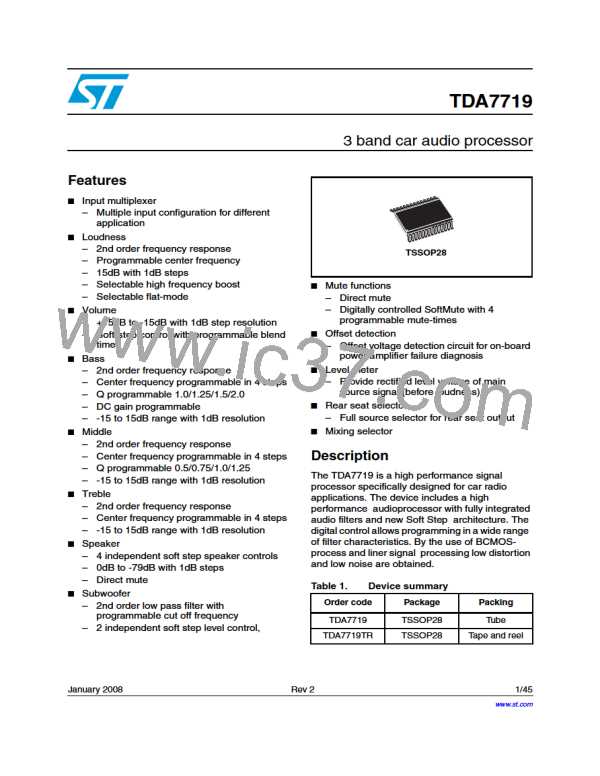Description
TDA7719
4.10
Softstep control
In this device, the softstep function is available for volume, speaker, loudness, treble, middle
and bass block. With softstep function, the audible noise of DC offset or the sudden change
of signal can be avoided when adjusting gain setting of the block.
For each block, the softstep function is controlled by softstep on/off control bit in the control
table. The softstep transient time selection (5ms or 10ms) is common for all blocks and it is
controlled by softstep time control bit. The softstep operation of all blocks has a common
centralized control. In this case, a new softstep operation can not be started before the
completion previous softstep.
There are two different modes to activate the softstep operation. The softstep operation can
2
be started right after I C data sending, or the softstep can be activated in parallel after data
sending of several different blocks. The two modes are controlled by the ‘act bit’ (it is
normally bit7 of the byte.) of each byte. When act bit is ‘0’, which means action, the softstep
is activated right after the date byte is sent. When the act bit is ‘1’, which means wait, the
block goes to wait for softstep status. In this case, the block will wait for some other block to
activate the operation. The softstep operation of all blocks in wait status will be done
together with the block which activate the softstep. With this mode, all specific blocks can do
the softstep in parallel. This avoids waiting when the softstep is operated one by one.
Chip Addr Sub Addr 0xxxxxxx
|↑ Softstep start here
Chip Addr Sub Addr 1xxxxxxx 1xxxxxxx
......
0xxxxxxx
|↑ Softstep start
here for all
1. It is not allowed to cross 0dB with softstep directly. From plus gain to minus gain, it must
go to +0dB first, then destination. From minus gain to plus gain, it must go to -0dB first,
and then destination.
2. When one block is in ‘wait for softstep’ status, it is not allowed to send data to this block
again before its softstep is completed.
3. To know if there is a softstep in operation, it is possible to monitor the ‘busy’ signal by
2
I C transmission mode (Section 5.1.2). When softstep is busy (busy=0), it is better to
wait before sending new data until it is free (busy=1).
24/45

 STMICROELECTRONICS [ ST ]
STMICROELECTRONICS [ ST ]